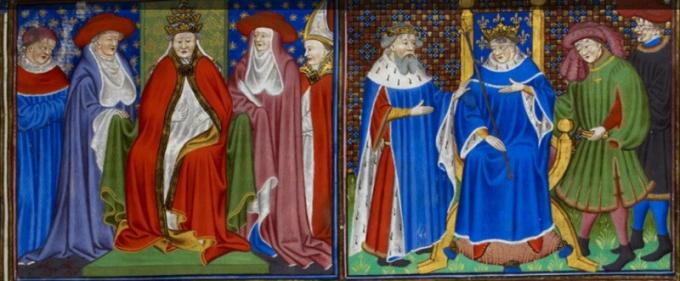16 curiosities about the Middle Ages
The Middle Ages It is one of the most misunderstood times in history due to the large number of hoaxes and legends that run about it. But, perhaps precisely because of this, it is much more interesting to delve into this period and rescue his true personality.
Interesting curiosities about the Middle Ages and medieval society
How were they embellished? What were the bathhouses and what was done in them? When was the Inquisition founded? Did the right of seigneur really exist? Who was Christine de Pizan?
We leave you 15 curious anecdotes about medieval times that will not leave you indifferent.
1. The myth of bad hygiene
Far from what is commonly believed, the Middle Ages was a period in which hygiene and personal care were the order of the day. In the wealthy classes, the ladies used countless beauty treatises to achieve what was the feminine ideal of the time: a pale, blond woman with perfect white teeth.
With this objective, the ladies' boudoirs abounded with oils and ointments, soap and perfumes. The most appreciated scents were the aroma of lavender, roses and orange blossom. Likewise, the ladies also had small depilatory tweezers to their credit, which they used mainly to remove facial hair. This gave rise to curious fashions, such as the one that was in vogue especially in the 14th and 15th centuries: completely plucking the eyebrows.
- Related article: "20 Curiosities of History that will surprise you"
2. Go to the bathhouses… to flirt
Bath houses were commonplace in the Middle Ages. Those who did not have bathtubs at home, could go for a small fee to the many establishments that were in the cities. There, the client washed, ate and chatted with his acquaintances, just as the Romans did in the baths.
A curious fact about these medieval bathhouses is that men and women shared the facilities and often the bathtubs. In the building there were also booths with beds, where those interested could have a good time in pleasant company.
3. Full color
Contrary to popular belief, medieval men and women worshiped colour. In the Middle Ages, this it was the reliable manifestation of God, while the color was nothing more than light, the divine emanation.

This love for colors was manifested in various ways: from the wonderful and colorful altarpieces to the stained glass windows of the cathedrals, passing, of course, through clothing. Often, this obsession with bright colors led them to combine impossible shades: it was not at all strange for a gentleman wearing one red hose and the other blue, or a lady covering her purple dress with a crimson shawl and her head with a veil yellow.
- You may be interested in: "The 15 branches of History: what they are and what they study"
4. The tallest chapines
If we believe that platform sandals are a modern invention, nothing could be further from the truth.. During the medieval centuries, the so-called chapines became fashionable, a type of footwear that women wore when going out on the street. These shoes, with cork soles and covered in velvet, could reach a height of up to... 50 cm!
5. The pope and the emperor don't get along
Yes, in the Middle Ages faith permeated everything. This is so. But what is not true is that the Church could do and undo at will. Starting with the Gregorian reform (11th century), the popes tried to impose their supremacy over temporal power, and the result was the beginning of a dispute between papacy and empire that lasted for centuries.
Relations between the popes and the Holy Roman Emperors were not always good. In fact, Emperor Henry IV dared to question the power of the papacy, and for this he was excommunicated twice. On his part, his successor, Federico II, reached the not inconsiderable figure of three excommunications.
6. Monasteries… double
Precisely until the Gregorian reform double monasteries (that is, where monks and nuns lived together) were quite common. The facilities were separated by the church from the monastery, but men and women shared common spaces such as the scriptorium. The case of the nun Ende is well known, considered one of the first women artists whose name is preserved, who illuminated the Blessed of Girona together with his companion, the monk Emeterio.
- Related article: "The 3 medieval estates: origin, history and characteristics"
7. Women Go on Crusades Too
Obviously not as warriors, but they did move physically to the Holy Land, following husbands and relatives. The myth of the maiden who stays in the castle, patiently waiting for the return of the crusader is just that, a myth. Yes, there were women who preferred to stay on their lands (where, by the way, they took the reins in absence of the husband), but there are other cases in which women embarked on an adventure with their husbands. Famous are the cases of Eleanor of Aquitaine, who accompanied King Louis VII of France on his journey to the holy places, and that of his successor, Queen Margaret of Provence, wife of Louis IX of France.
8. The tragic story of Abelardo and Eloísa
Long before the legend of Romeo and Juliet was born, there was a couple in love of whom we do have absolute proof. They lived in the 12th century, when universities were taking off, and were characterized by their education and culture. We are talking about Pedro Abelardo and Eloísa de Argenteuil.
She was his student, and during the lessons they fell deeply in love. Eloísa's uncle was opposed to romance and, despite the fact that the young people got married and that Eloísa had had a son, they finally had to separate and enter separate convents.
9. In the Middle Ages they also laughed
While it is true that the Church did not always see laughter favorably, there was no shortage of works and festivals in the Middle Ages that incited general laughter. For example, the well-known book Cyprian's dinner (Coena Cypriani), an authentic parody of various characters from the Holy Scriptures. Although the writing ultimately has a moralizing objective, it turns out to be one of the satirical and burlesque monuments of medieval times.
10. A Viking princess in Castile
In the 13th century, the Scandinavian kingdoms were opening their diplomatic sights to Europe. With the aim of establishing a political alliance, the King of Norway agreed to the marriage of his daughter Cristina with Felipe de Castilla, who also at that time was a candidate for the throne of the Sacred Empire. Thus, the young Norwegian undertook a journey in the summer of 1257.
Cristina and Felipe married a year later, and settled in Seville. Legend has it that the princess languished with longing and that she did not adapt to the Hispanic lands. Whether it was due to melancholy or illness, the truth is that Cristina died in 1262, at the age of twenty-eight.
11. The beaterios or beguinaries
It is possible to find old beguinages, especially in the Flanders region. Its origin is in the so-called beguines, women who lived in community without professing vows in any religious order and who dedicated their lives to prayer, contemplation and works of charity. They financed themselves by selling the fruit of their work, such as garden products or handicrafts.
During the Middle Ages, the enclosures where women who wished to seclude themselves became popular. They only had to take a vow of chastity, and they could abandon it whenever they wanted to get married. These houses represented a veritable refuge for widows and forlorn women who might otherwise have fallen into the pit of prostitution.
12. pioneer of modern feminism
In the thirteenth century, the Roman de la Rose, a novel that deals with love. Some of its parts, especially those added later by Jean de Meung, were eminently misogynistic, in line with prevailing ideas about the supposed inferiority of women.
Christine de Pizan was a young woman of Venetian origin who had been forced to write to earn a living, since she, at only twenty-five years old, had been left a widow with two dependent children. Strongly impressed by Meung's misogynistic words, and fed up with the continuous harassment she received from her, she wrote the the city of ladies, an allegorical text inspired by the city of god of San Agustin where the writer defends women as equals to men. The work, as well as its author, have been considered as precedents of modern feminism.
13. Laws for brothels
The Middle Ages exhibited an astonishing tolerance for prostitution, which came to be considered a "necessary evil.", especially during the last centuries of the period. The authorities therefore established a series of laws that sought to control prostitution in the cities as much as possible.
For example, in the 13th century Montpellier, activity was allowed only in one of the streets of the city, but not outside, but inside the "official" brothels. Often, these premises were marked with elements of the façade; This is the case of the brothels of Barcelona, with famous "carasses", the faces that adorn their corners.
14. The Inquisition is founded
Another erroneous fact about the Middle Ages is that the Inquisition was present during the entire period. Again, nothing could be further from the truth.
The Holy Office was not established until 1184, on the occasion of the Albigensian Crusade or Crusade against the Cathars, a heresy of Eastern origin that had taken deep roots in the south of what is now France. Heresy was dangerous as long as it questioned the foundations of medieval society; For this reason, the papacy exhorted the lords of France to a crusade against the Albigensians, which resulted in the total extermination of the doctrine and the annexation of Languedoc to the kingdom of France.
15. The table was "set"
Have you ever wondered where the expression “set the table” comes from?. In the Middle Ages, very little furniture was fixed in place; most were portable and moved as needed. Most of the tables were nothing more than a wooden board and several easels, depending on the diners who sat down to eat. Thus, it was only installed when it was time for food, and when it was finished, the table was “cleared”.
16. The mythical “derecho de seigneur”
Especially famous thanks to movies and novels, the medieval seigneur's right or jus primae noctis (first night use) is just that, a fable. At least, historians have found no reliable documentation that such a right existed.
It is possible to think that, if the pernada were a legal right, there would have been written documents, especially considering that the medievals transcribed absolutely everything. The confusion may come from the serf's obligation to ask his lord for permission to marry, and to pay an economic tribute for this purpose.

